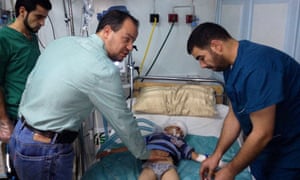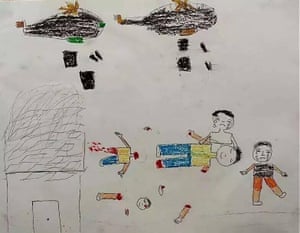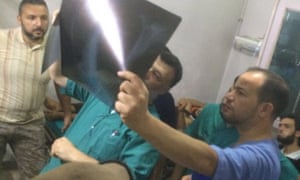The Guardian

Dr Zaher Sahloul (left, front) treats a child casualty in a Syrian hospital Photograph: Handout
Link
Dr Zaher Sahloul has worked in Aleppo and seen the horrific affect of airstrikes. He says incidents like that which left Omran Daqneesh stunned and bloodied are all too common in a city under siege
The pictures of the injured five-year old Omran Daqneesh have shocked the world, but doctors in Aleppo see dozens of desperate children like him every week, often with worse injuries and many entirely beyond help.
Perhaps his individual tragedy will have a small silver lining if it reminds people far beyond Syria of the tragedy that has been unfolding there for years. Every time I work there I treat children, often so terribly wounded and traumatised that I wonder if the ones who survived were unluckier than the ones who died.
I keep a picture from a second-grader in Aleppo, of helicopters bombing the city, blood and destruction below, but what is really shocking for me is that the dead children are smiling while the living ones are crying.
I also keep photos of my first ever patient in Aleppo, a toddler called Hamzeh who had been shot by a government sniper, and brought to the hospital intensive care unit with a bullet in his brain. I had to tell his family he was brain dead, and then turn off the ventilator, which can be particularly hard in Syria because if the heart is beating many people cannot accept their child has no hope of surviving.
Then there was Abdullah, who was 12, and injured by shrapnel from a barrel bomb. He asked me, screaming in pain but still somehow polite, to stop trying to insert a tube into his chest without anaesthetic.
“I kiss your hand uncle, please stop,” he begged me, but we had no painkillers and he would die if I did not drain the blood pooling around his lungs, so I carried on. I also think often of the two young sisters who were brought to another emergency room hugging each other, but already dead.
Omran survived, without losing a limb or an eye, but he will be traumatised forever. And there are bombings every day, so who knows what will happen in coming days or weeks, he could be hit again.
We say this is a powerful picture, but will it translate into meaningful action to protect these children? They are not dolls to cry over and then move on. That is the worst thing, everyone is looking at these pictures, but who will do anything?
Last time I entered the outskirts of Aleppo, the air thick with the stench of death from decaying bodies, gunfire and explosions in the distance, our driver warned us “say your final prayers now” in case we didn’t make it.
I could never have imagined I would take such risks with my life when I went to medical school, when the main thing we expected to worry about was lawsuits. And after each medical mission to Syria, people ask me how I can leave my loving family and comfortable home in Chicago, knowing I may not come back.
I ask this question myself sometimes, sipping morning coffee in my suburban backyard, watching birds and butterflies.
But then a message arrives from Syria, asking for help treating a gruesome injury shown in an iPhone photo, informing me of the death of another colleague or sharing images of a devastating new attack, and all the pleasure of my day-to-day life dissipates in a moment.
I go there so I can come back and bear testimony to the tragedy unfolding, to show solidarity to the few remaining brave doctors and nurses in rebel-held east Aleppo, but also because our help is needed in these areas.
After years of bombing by Russian and regime aircraft, hundreds of doctors have been killed or fled. Only 35 remain in the city to serve more than 300,000 civilians, and there is not a single critical care doctor - my own speciality - even though there is an abundance of critically ill patients.
During my dozen medical missions to Syria, I have had to trust smugglers and brave Aleppo’s sniper alley, crawl under border fences, jump walls, walk for hours without light over mountain passes, wait in basements for jets overhead to pass.
But the memories that haunt me, that I cannot escape, are not of personal danger. They are the ones from the hospitals where I have worked, of those I did not have the time, the staff or the equipment to save.
What would you do if you have a child with head injuries from a barrel bomb and you don’t have a CT scanner to figure out if she has bleeding on the brain or not? What would you do if your hospital is bombed, but it is the only place in town providing healthcare to a helpless population? Do you leave or stay?
These are real dilemmas that doctors there have to face, and as they work to keep others alive. It is always at huge risk to themselves.
I think often of doctors like Hasan Alaraj, a cardiologist from Hama, whose last operating theatre was inside the “central cave hospital”, dug into the heart of a mountain for protection. He was killed anyway by an airstrike, when his car was hit on the way to work.
What is going on in Syria is a medical emergency that has been unfolding in slow motion for five years. We can and we should do our part. We can’t wait for politicians to fix the crisis. We can’t wait for a no-fly zone to stop the bombing.
Doctors can save many lives by doing what we do best, using our stethoscopes, skills and compassion. Aid groups and the people who fund them can save many more by delivering medical supplies, ambulances and life-saving medications across the border, training local doctors and nurses, setting up mobile clinics to reach displaced populations.
Inside Aleppo’s fortified or underground hospitals protected from bombs, portable technology that can be hidden or moved after bombing raids and telemedicine connecting overworked doctors to experts overseas all save lives.
All of us can help by advocating on behalf of the doctors and their patients, refusing to accept their suffering is normal, even if the world can sometimes seems inured to Syria’s pain. Every life is precious. Omran has reminded us all of the terrible suffering of the children caught up in this war. Let us not forget them again.
Zaher Sahloul is a critical care physician from Chicago. A Syrian American member of medical charity SAMS and founder of American Relief Coalition for Syria, he has worked in Aleppo and several other parts of Syria as a volunteer, and testified about the situation there to the UN.



No comments:
Post a Comment